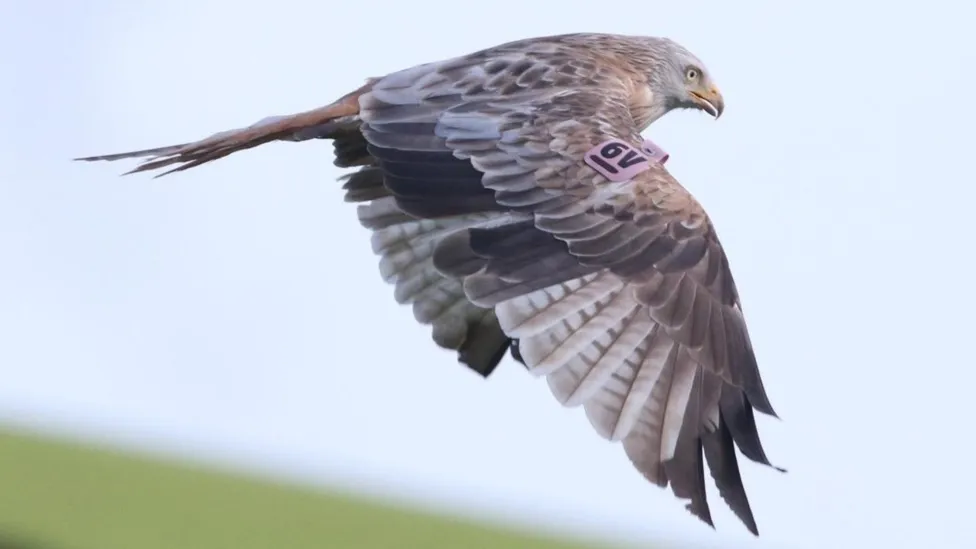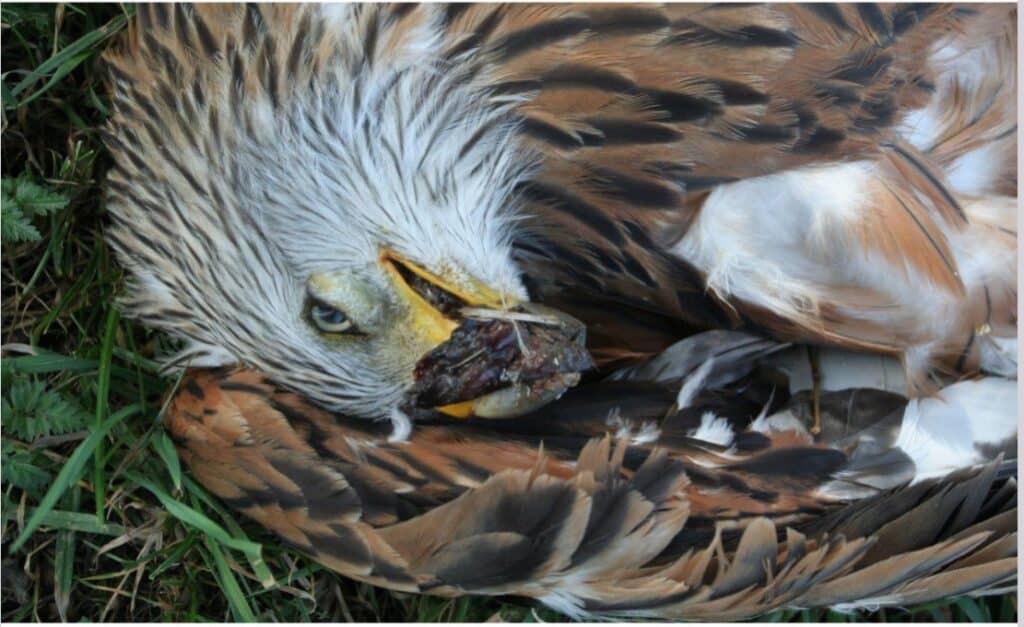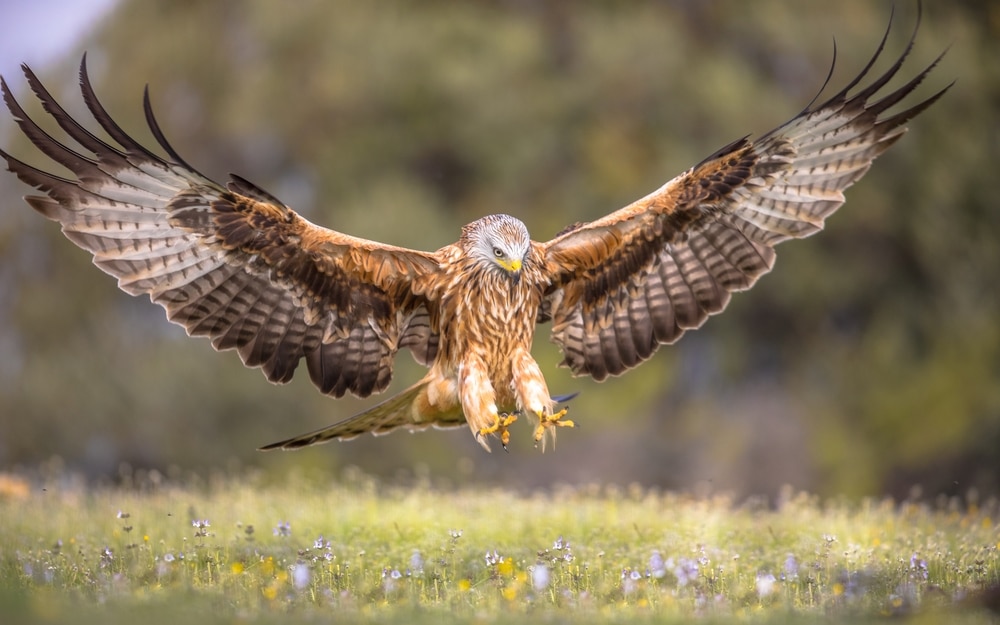A Red Kite was so seriously injured in a shooting last month that she had to be euthanised by a vet treating her.
Well-known throughout the Mournes, in Co Down, the bird, nicknamed Vivienne after the identifying tags ‘6V’ attached to her wing, was found injured in Newry, on Saturday, April 20. X-rays found that pellets were embedded in her wing and neck, fracturing the humerus.
Police officers from the PSNI (Police Service for Northern Ireland) are investigating the shooting as a wildlife crime and have appealed to the public for help in finding out who was responsible.
A spokesperson from the PSNI has been widely quoted in local media:
“Following an x-ray on April 22, and later confirmation from Agri-Food and Biosciences (AFBI), it became evident in the x-ray that the bird had been shot, as pellets were embedded in its wing and neck, including a fracture to its humerus.
The Red Kite is a large, protected bird of prey, re-introduced to Northern Ireland in 2008 and is a truly beautiful raptor with distinctive markings, recognised by its fork tail.
This Red Kite, nicknamed ‘Vivienne’ due to its identifying wing-tags brown-pink 6V, was well-known in the area and throughout the Mournes since it was born here back in 2018.
At this time, we are asking for information from the public due to offences falling under the Wildlife (NI) Order 1985 as amended by the Wildlife and Natural Environment Act (NI) 2011.
Police take all wildlife crime very seriously and are appealing to anyone who has information about what may have happened to this protected bird to call us on 101, quoting reference number 1229 22/04/24.
If you are aware of anyone in the area intent on harming birds of prey, please contact police.”

Vivienne
Vivienne was native to the County Down area, hatching in 2018 from a nest in the Dromara Hills. She well-known locally because of her unusually pale plumage
“She had been admired by birdwatchers, members of the local community and visitors and was regularly seen in the Dromara area,” according to Dean Jones, an RSPB Investigations Officer.
Vivienne had been previously rescued by Red Kite volunteers in 2021 after she was found in poor condition. On that occasion she was successfully rehabilitated and returned to the wild. Mr Jones said her premature death three years after that rescue “really highlights the risk that birds of prey face on a day-to-day basis in Northern Ireland, all because some individuals choose to kill them”.
Reintroduction
Red Kites were reintroduced to Northern Ireland in 2008 after an absence of more than 200 years. Originally wiped out by persecution, there are currently about 25 territorial pairs in Northern Ireland, but illegal persecution dogs the recovery of the species.
Just as in the rest of the UK, all birds of prey in Northern Ireland are protected all year under the Wildlife (Northern Ireland) Order 1985, as amended by the Wildlife and Environment Act (NI) 2011 and it is illegal to disturb them at, in, on or near their nests. Vivienne is believed to be the 18th Red Kite illegally killed in Northern Ireland, though, since the species reintroductions started.
“The shooting of Vivienne is just the latest in a growing number of raptor persecution cases in the country and these are likely to be only a small proportion of the actual numbers being killed,” according to Jones.

Red Kite persecution
With its reddish-brown body, deeply forked tail, and effortlessly graceful flight the Red Kite is one of the most recognizable birds of prey in Britain. Almost entirely confined to Europe (with possibly a few pairs still in Morocco), they occupy a mosaic of different habitats including mature deciduous and mixed forests, forest edges, clearings, meadows, cultivated fields, pastures, Mediterranean bush, farmland, scrub habitat, wetlands, and olive tree plantations.
Fairly weak hunters in comparison with other raptors, Red Kites are scavengers and typically feed on dead animals and road kill, though they have been seen to take animals such as mice, voles, rabbits, crows and pigeons. They also eat invertebrates such as beetles and earthworms, especially in Spring.
For a bird that is widespread and generally fairly unfussy about what it eats, an enormous amount of conservation work has had to take place to avoid the species’ extinction. Persecuted for centuries, suffering from secondary poisoning from pesticides, and impacted by huge habitat changes across Europe, populations have crashed in many areas.
While huge efforts to build the population back up have been successful in (especially) many parts of England, Red Kites continue to be illegally persecuted.
Amongst numerous recent examples of illegal persecution of Red Kites:
-
- A 2016 report in the Northern Echo reported concerns were “growing for the region’s Red Kite population after another of the birds was shot in North Yorkshire – the tenth to die in the past two months”.
- IN 2017, Red Kite ‘Black 5W’, was found dead with gunshot wounds in County Down. He was born just three months earlier at a nest site near Downpatrick.
- In 2020 three Red Kites were shot and killed in a ‘horrific’ attack near Newtown (mid-Wales).
- A Red Kite was killed in an illegal trap on an unnamed Berkshire pheasant-shooting estate.
- A Red Kite was found shot and killed near Leeds.
- A poisoned Red Kite was found on the Moy Estate (near Cairngorms National Park) – which partly led to the estate having its General Licence removed in 2022.
- A Red Kite was found shot in Cirencester near one of Gloucestershire’s largest pheasant shoots.
- In 2022 Wiltshire gamekeeper Archie Watson was sentenced after dumping the body of a shot buzzard into a covered well that was later found to contain eleven buzzards and four Red Kites.
- In December 2022 Raptor Persecution UK reported that Police Scotland had only just released news of a young Red Kite found poisoned on a grouse moor (Dava Moor) in May 2021: no further details were released.
- In March 2023 Police Scotland appealed for information after a witness reported a Red Kite being shot on a grouse moor estate near Grantown-on-Spey.
- In March 2023 a Red Kite was found shot and dying on a grouse moor in Co Durham.
- The body of a Red Kite was found near North Creake in Norfolk in August 2023: tests proved it had ingested bendiocarb.

